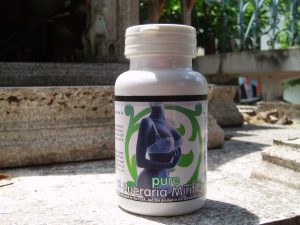The direct translation of mirifica is “miracle-maker.” And when I heard what this herb could do, I decided that the name couldn’t be more appropriate. For centuries, Pueraria Mirifica has been working magic that (until now, at least) most of us have only seen in big-budget Hollywood films-or in our absolute wildest dreams.
And if all that isn’t compelling enough, imagine being able to combat breast cancer, ovarian cancer, cervical cancer and prostate complications-all with this single “miraculous” herb. If you don’t believe me, just take a look at the numerous published studies that have been performed on Pueraria Mirifica. Even better, ask the virile, active, and anything-but-elderly Thai villagers who have consumed variations of this plant every day for generations.
An anti-aging powerhouse that’s less toxic than water
The first recorded account of Pueraria Mirifica dates all the way back to 14th century Thailand, where the highest order of monks in the Northern Kingdom would receive tonics crafted from the herb as gifts
from local inhabitants. Today, you can still read the ancient palm leaves that are inscribed with the plant’s numerous (and incredible) capabilities, which were translated into modern Thai by scholars in the 1930s.
That’s because Pueraria Mirifica has sole bragging rights to a unique compound called miroestrol. It’s nearly identical in molecular structure to estriol, one of the three main estrogens produced by the human body in both genders. But more importantly, you won’t find another compound with more potent estrogenic activity anywhere in nature.
Analysis has shown that miroestrol-and its precursor deoxymiroestrol-has approximately 3,000 times the estrogenic activity of soy isoflavones and is more than 100 times more powerful than red clover, two of the most popular alternatives for natural menopause relief today. But as scientists explained to me, this particular phytoestrogen doesn’t work in quite the same way. In fact, it’s far safer.
Pueraria Mirifica doesn’t simply mimic estrogen in the body the way that other therapies do, whether bio-identical or not. Instead, the herb (much like the human byproduct it resembles) acts on estrogen receptors. In more clear terms, it acts as a balancing agent: When levels of estrogen are too high, Pueraria Mirifica will tie up receptors to weaken the hormone’s effects-when levels are low, the herb exerts the necessary estrogenic activity without actually increasing the amount of estrogen in your body.
As a result, your hormones are modulated and signs of aging linked to your body’s numerous estrogen-receptors (whether it’s menopausal symptoms, wrinkles, balding, or graying hair) are halted or reversed. And without any risk of toxicity, either.
On the LD50 test (which measures the dosage that would kill laboratory animals after 14 days, expressed in weight of material per kilogram of body weight), simple water scores a 16. Relative to this, dried Pueraria Mirifica root scores a more toxic 7-but when the root is administered in the form of a standardized extract, the score raises to 40, causing no animal deaths at all.
In short: It’s less toxic than water.
Night sweats stopped in as little as six days
Just as important as Pueraria Mirifica’s safety, though, is that it actually works. Fortunately, several studies suggest that it can effectively relieve several of the many symptoms of menopause. One study showed that Pueraria Mirifica improved vascular function in ovariectomized rabbits, showing the herb’s promise as a heart-protective for menopausal women.1 Another demonstrated Pueraria Mirifica’s ability to prevent bone loss in rat models.2 And just as many human trials show that these results carry over to women as well.
A larger Phase II trial was conducted in 2004, in which researchers evaluated the symptoms of 37 perimenopausal women (including hot flashes and night sweats). Of the 37 trial subjects, 20 were randomly assigned a dose of 50 mg of Pueraria Mirifica per day-the other 17 received a dose of 100 mg.
The results were positive-and began to show as soon as six days after treatment, leading study authors to conclude that “Pueraria mirifica demonstrates great promise in the treatment of climacteric symptoms among perimenopausal women.”
But as they say, every rose has its thorn-and Pueraria mirifica appears to be no exception. In trial subjects, there have been reports of breast pain, vaginal discharge, headaches, and even a few cases of vaginal spotting in menopausal women supplementing with Pueraria Mirifica -an occurrence that would most likely send you running to your doctor for a cancer screening. (Bleeding after menopause is almost always a serious warning sign.)
But while this is definitely a potential side effect that might lead you to reconsider including the herb in your daily arsenal, research actually suggests that supplementing with Pueraria Mirifica could help to eliminate worries of hormone-dependent cancers-like breast cancer-altogether.
Even a quick glance at global cancer statistics will reveal a striking point of contrast: Rates of breast cancer in particular are more than 10 times lower in Thailand than here in the United States. This is a difference that’s impossible to ignore-and also one that has sent scientists searching for an explanation. They may have found their answer in Pueraria mirifica.
Scientists believe that Pueraria Mirifica’s active compound miroestrol acts similarly to the breast cancer drug tamoxifin, insofar as it occupies estrogen receptors without triggering the chemical cascade that leads to pre-cancerous cell division. And this hypothesis is supported by a growing body of studies, which reveal that Pueraria Mirifica can inhibit the growth of breast cancer cells in particular.
Benefits that reach far beyond menopause
In total, the studies around Pueraria Mirifica have been mixed, with some demonstrating the herb’s great potential, and others suggesting it may come at a price. Dr. Vichai is quick to say that the latter research simply needs to be more thorough. What could look like a trigger for potentially dangerous cell division on the surface would reveal itself to be increasing cancer-fighting cells upon closer inspection, he argues.
The Thai Ministry of Health enthusiastically supported this same conclusion in a 2001 public declaration, citing clinical research that proves Pueraria Mirifica’s safety–and its promise in the search for new cancer treatments. But for now, the jury-on paper, at least-still appears to be out.
What’s certain, though, is the mountain of epidemiological evidence behind Pueraria Mirifica’s powers, in the form of centuries of use by Thai men and women. Dr. Vichai detailed many stories to me: In one particularly memorable account he described an 82-year-old woman whose daily consumption of Pueraria Mirifica kept her hair naturally jet black, and her body as spry as a woman decades her junior.
Amazingly, she still had the energy she needed to chase after her grandchildren.
Another local man (also in his 80s) seemed confused when asked how often he arose from sleep at night to urinate. To him-and all of the other male villagers who had been eating Pueraria Mirifica root every day for years-disturbances of this nature were unheard of. Dr. Vichai has even seen his own hair restored and wrinkles fade-after all, men experience side effects from estrogen imbalances, too, like balding, lower sexual performance, and more porous bones.
But the younger population can benefit from Pueraria Mirifica, too, he told me-with the prevalence of hormones in our food supply, a natural estrogen adaptogen like this one can be crucial at any age. Last, but not least, Dr. Vichai didn’t fail to mention several LA Lakers cheerleaders who have seen excellent results from his Pueraria Mirifica formulation for breast enhancement-perhaps a less urgent, but equally astounding “perk” of the product.
To his mind, Pueraria mirifica is nothing short of a fountain of youth-and the possibilities, he says, are vast. Even now, research is in the works that will investigate the herb’s potential, not just against menopausal discomfort and cosmetic aging, but also against prostate concerns, osteoporosis, and possibly even Alzheimer’s. But in the meantime, the herb’s availability is still limited, and the American market may not quite be ready to embrace it. Still, there are a few scant sources that have begun to open the door.




Leave a Reply
You must be logged in to post a comment.